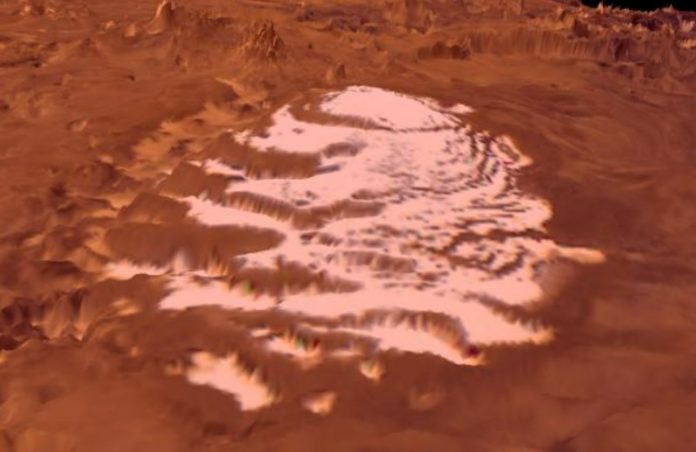In a paper, Isaac Smith, a researcher at the Planetary Science Institute, says that carbon dioxide glaciers are moving and leaving behind deposits that are kilometers thick. This could have been going on for more than 600,000 years.
“The CO2 deposits that were first identified in 2011 turn out to be flowing today, just like glaciers on Earth,” remarked Smith, lead author of the paper published in the Journal for Geophysical Research – Planets.
“Approximately 600,000 years ago CO2 ice started forming at the Martian south pole. Due to climate cycles, the ice has increased in volume and mass several times, interrupted by periods of mass loss through sublimation,” Smith explained. “If the ice had never flowed, then it would mostly be where it was originally deposited, and the thickest ice would only be about 45 meters thick. Instead, because it flowed downhill into basins and spiral troughs – curvilinear basins – where it ponded, it was able to form deposits reaching one kilometer thick.
“The glaciers have enough mass that if sublimated, they would double the atmospheric pressure of the planet. It’s a stunning quantity, and a 2018 paper by PSI Senior Scientist Than Putzig measured it most accurately,” Smith added. “The longest glacier is about 200 kilometers long and about 40 kilometers across. These are big! That activity is ongoing, but flow rates probably peaked about 400,000 years ago when the deposition was greatest. We’re in a slow period because the ice is decreasing in mass, and that slows down glaciers.”
Recent research partially undertaken at PSI (and supported by Smith) explored the flow laws or strength properties of carbon dioxide ice. In Martian circumstances and on steep slopes, CO2 ice flows over 100 times faster than H2O ice, according to that research. This is why the CO2 ice acts like glaciers, despite the fact that the rest of the H2O ice cap supporting it appears to be fixed.
Analysis of glacial modeling results using NASA’s Ice Sheet and Sea-Level System Model, which Smith modified to work on Mars and with CO2, revealed that the CO2 ice had not been moved by conventional techniques. “Atmospheric deposition would put the ice in a pattern we don’t see. It would be much more evenly spread and thinner. What the glacier interpretation provides is a mechanism to move the ice from high places, into the lower basins that are also at a lower latitude,” Smith explained. “If atmospheric deposition were the only process acting on the ice, then most of it would be found at the highest latitude and highest elevation. That’s just not the case. The ice is flowing downhill into basins, much like water flows downhill into lakes. Only glacial flow can explain the distribution we found in 2018.”
Smith and his team went on to find various surface features that are extremely similar to those found on terrestrial glaciers. Topographic profiles, crevasses, and compression ridges resembling terrestrial characteristics are among them. This made the conclusions stronger and gave us a way to compare them to the models.
The only bodies in the Solar System known to have actively flowing ice are Earth, Mars, and Pluto, but they’re not alone. There are many other types of ice in the solar system, and if the number of dwarf plants grows, it’s conceivable that some of them will have carbon monoxide or methane glaciers, which would be even more unusual than the dry ice glaciers recently discovered on Mars.
Image Credit: NASA data visualized using JMARS
You were reading: A Surprising Phenomenon Similar To Earth Recorded On Mars
